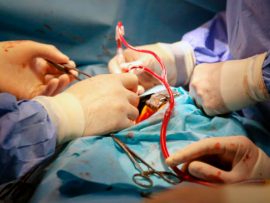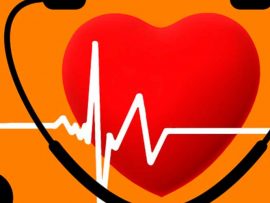Abstract We aimed to describe the clinical outcomes of veno-arterial extracorporeal membrane oxygenation (VA-ECMO) therapy in our institution considering clinical context and pH at cannulation. All patients treated by VA-ECMO during the..
Lee masAbstract OBJECTIVES Upper gastrointestinal bleeding (UGIB) is a common complication in adults treated with veno-arterial extracorporeal membrane oxygenation (VA-ECMO) for refractory cardiogenic shock or cardiac arrest. We aimed to determine..
Lee masAbstract Background Extracorporeal membrane oxygenation offers temporary hemodynamic support for patients with refractory cardiogenic shock after cardiovascular surgery. However, the initiation time for such patients is controversial. Changing the initiation..
Lee masAbstract Introduction: Massive acute pulmonary embolism (MAPE) with obstructive cardiogenic shock is associated with a mortality rate of more than 50%. Venoarterial extracorporeal membrane oxygenation (VA-ECMO) has been increasingly used..
Lee masAbstract Venoarterial extracorporeal membrane oxygenation provides cardiorespiratory support to patients in cardiogenic shock. This comes at the cost of increased left ventricle (LV) afterload that can be partly ascribed to retrograde..
Lee masPrognosis of Venoarterial Extracorporeal Membrane Oxygenation in Mixed, Cardiogenic and Septic Shock
Abstract Mixed cardiogenic-septic shock (MS), defined as the combination of cardiogenic (CS) and septic (SS) shock, is often encountered in cardiac intensive care units. Herein, the authors compared the impact of..
Lee masAbstract Refractory cardiogenic shock is increasingly being treated with veno-arterial extracorporeal membrane oxygenation (V-A ECMO), without definitive proof of improved clinical outcomes. Recently, pulsatile V-A ECMO has been developed to address some of the..
Lee masAbstract Background It is currently unclear if active left ventricular (LV) unloading should be used as a primary treatment strategy or as a bailout in patients with cardiogenic shock (CS)..
Lee masAbstract Background The mortality rate for a patient with a refractory cardiogenic shock on venoarterial (VA) extracorporeal membrane oxygenation (ECMO) remains high, and hyperoxia might worsen this prognosis. The objective..
Lee masAbstract Veno-arterial extracorporeal membrane oxygenation (V-A ECMO) is an increasingly used rescue therapy forpatients with refractory cardiogenic shock (CS) 1,2 . It provides mechanical circulatory support for both heartand lungs..
Lee masAbstract Background: Exposure to hyperoxia, a high arterial partial pressure of oxygen (PaO2), may be associated with worse outcomes in patients receiving extracorporeal membrane oxygenator (ECMO) support. We examined hyperoxia in..
Lee masAbstract Background High-risk patients with coronary heart disease who develop acute myocardial infarction (AMI) have severe coronary lesions. If severe complications occur, such as malignant ventricular arrhythmia, cardiogenic shock, and..
Lee masAbstract Despite venovenous or venoarterial (ECMO) being increasingly used in patients with severe syndrome, severe , and refractory cardiac arrest, mortality rates still remain high mainly because of the severity..
Lee masAbstract Background Outcomes of patients requiring venoarterial extracorporeal membrane oxygenation (VA-ECMO) vary greatly by etiology, but large studies that incorporate the spectrum of shock supported with ECMO are rare. Objectives..
Lee masAbstract Extracorporeal membrane oxygenation (ECMO) is increasingly used to provide mechanical support in refractory acute respiratory distress syndrome and/ or refractory cardiogenic shock. It is associated with a high prevalence..
Lee masAbstract Venoarterial extracorporeal membrane oxygenation (VA ECMO) is a form of temporary mechanical circulatory support and simultaneous extracorporeal gas exchange for acute cardiorespiratory failure, including refractory cardiogenic shock (CS) and..
Lee masAbstract Myocardial infarction (MI) is typically followed by numerous lethal complications. One such complication is left ventricular free wall rupture (LVFWR). We present the case of a middle-aged hypertensive patient..
Lee masAbstract VA-ECMO is commonly used for patients in cardiogenic shock (CS) or refractory cardiac arrest (CA) undergoing PCI for ACS. In this setting at high risk of both thrombotic and..
Lee masAbstract Purpose: Veno‑arterial (VA) extracorporeal membrane oxygenation (ECMO) can be used to restore organ perfusionin patients with cardiogenic shock until native heart recovery occurs. It may be challenging, however, to..
Lee masAbstract Aims Venoarterial extracorporeal membrane oxygenation (VA-ECMO) is currently one of the most used devices in refractory cardiogenic shock. However, there is a lack of evidence on how to set..
Lee masAbstract The time between onset of cardiogenic shock and initiation of mechanical circulatory support is inversely related to patient survival as delays in transporting patients to the operating room (OR)..
Lee masAbstract In patients in cardiogenic shock (CS), mechanical circulatory support (MCS) may improve systemic perfusion without increasing myocardial work. Restoration of oxygen delivery with reduced myocardial oxygen demand favors myocardial..
Lee masAbstract Background: Veno-arterial extracorporeal membrane oxygenation (VA-ECMO) is increasingly being used for circulatory support in cardiogenic shock patients, although the evidence supporting its use in this context remains insufficient. The aim..
Lee masAbstract Objectives Simultaneous mechanical (MCS) with intra-aortic balloon pump (IABP) to (ECMO) is common in postcardiotomy (PCS). This study aimed to analyse the effect of concomitant ECMO and IABP therapy on the short-term..
Lee masAbstract Post-infarction ventricular septal rupture (VSR) is a serious complication of myocardial infarction, which, in its natural course or treated medically, is related to high mortality rate. Surgical intervention remains..
Lee masAbstract CentriMag® extracorporeal VAD support could represent a more physiological choice than conventional ECMO in primary cardiogenic shock. We therefore evaluated the outcome of patients with primary cardiogenic shock who were..
Lee masAbstract Background: Postcardiotomy cardiogenic shock (PCS) that is refractory to inotropic support remains a major concern in cardiac surgery and is almost universally fatal unless treated with mechanical support. While reported..
Lee masAbstract Danvers, Mass., October 21, 2022 – (Nasdaq: ABMD) announces the U.S. Food and Drug Administration (FDA) has accepted and closed the post-approval study reports related to the pre-market approvals (PMA)..
Lee masAbstract Importance Intravascular microaxial left ventricular assist device (LVAD) compared with intra-aortic balloon pump (IABP) has been associated with increased risk of mortality and bleeding among patients with acute myocardial infarction..
Lee masAbstract We applied the Society for Cardiovascular Angiography and Interventions (SCAI) schema to cardiogenic shock (CS) patients treated with venoarterial extracorporeal membrane oxygenation (VA-ECMO) to assess performance in this high..
Lee mas
















